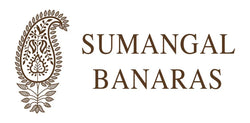Indian handloom sarees are renowned for their exquisite craftsmanship, and among the most popular choices are Banarasi sarees and Kanjivaram sarees. Both are rich, luxurious, and perfect for grand occasions, but each has its unique charm and heritage. If you are confused about which saree to choose for your next big event, this guide will help you understand the differences and pick the one that suits your style best.
1. Origin and Heritage
Banarasi Saree
A Banarasi silk saree originates from Varanasi (Banaras), Uttar Pradesh, and has been woven since the Mughal era. These sarees are known for their intricate zari (gold and silver thread) work, Mughal-inspired motifs, and luxurious silk fabric. Over the centuries, they have become a staple for weddings and festive occasions.
Kanjivaram Saree
A Kanjivaram saree hails from Kanchipuram, Tamil Nadu, and is often referred to as the "Queen of Silks." These sarees are crafted with pure mulberry silk and real gold or silver zari work, making them exceptionally durable and grand. They are deeply associated with South Indian culture and are often worn by brides.
2. Fabric and Texture
Banarasi Silk Saree
-
Made from fine silk, organza, or georgette.
-
Has a soft, smooth texture with a slight sheen.
-
Available in lightweight versions like the Banarasi georgette saree, making them comfortable for all-day wear.
Kanjivaram Silk Saree
-
Made from pure mulberry silk, giving it a heavier and more structured feel.
-
The thick weave makes it more stiff and durable compared to Banarasi sarees.
-
Has a natural golden shine due to the use of real zari.
3. Weaving Technique and Motifs
Banarasi Saree
-
Uses the kadwa (handloom) weaving technique, which involves intricate brocade patterns.
-
Features Mughal-inspired motifs such as floral patterns, paisleys, jaali (net), and birds.
-
Comes in variations like Banarasi georgette saree for a lighter and more flowy drape.
Kanjivaram Saree
-
Uses three-shuttle weaving, which makes the body and border of the saree distinct.
-
Features temple-inspired designs, checks, stripes, and motifs like elephants and peacocks.
-
Has a thick border with a different color than the body, making it visually striking.
4. Color Combinations and Designs
Banarasi Silk Saree for Wedding
-
Comes in rich shades like red, maroon, royal blue, emerald green, and deep gold.
-
Often features tone-on-tone patterns and detailed gold zari work.
-
A red Banarasi saree is a popular bridal choice in North India.
Kanjivaram Saree
-
Known for its contrasting color combinations between the body and border.
-
Features bold shades like bright pink, mustard yellow, deep purple, and orange.
-
The zari work is often thicker and more pronounced.
5. Best Occasions to Wear
Banarasi Saree for Wedding
-
Perfect for brides, wedding guests, and festive occasions.
-
A Banarasi silk saree for wedding exudes royalty and elegance, making it a favorite among North Indian brides.
-
Lighter Banarasi sarees, such as Banarasi georgette saree, are great for pre-wedding functions or receptions.
Kanjivaram Saree
-
Ideal for South Indian weddings, temple functions, and cultural ceremonies.
-
Preferred by brides from Tamil Nadu, Kerala, Karnataka, and Andhra Pradesh.
-
Can be worn for traditional festivals like Pongal and Navratri.
6. Price Range
-
Banarasi silk sarees vary in price depending on the fabric, zari work, and weaving technique. Pure handwoven Banarasi sarees can range from ₹10,000 to ₹2,00,000 or more.
-
Kanjivaram sarees are generally more expensive due to the pure mulberry silk and real gold zari used in weaving. Prices start from around ₹15,000 and can go up to ₹5,00,000 for premium designs.
7. Which One Should You Choose?
|
Feature |
Banarasi Saree |
Kanjivaram Saree |
|
Best for |
North Indian weddings, festivals, parties |
South Indian weddings, temple functions |
|
Fabric |
Silk, georgette, organza |
Pure mulberry silk |
|
Weave Style |
Fine, soft, and flowy |
Thick, stiff, and structured |
|
Zari Work |
Intricate and delicate |
Heavy and bold |
|
Weight |
Light to medium |
Heavy |
|
Price Range |
₹10,000 - ₹2,00,000 |
₹15,000 - ₹5,00,000 |
|
Popular Colors |
Red, maroon, gold, pastel shades |
Bright pink, mustard yellow, purple, green |
Go for a Banarasi Saree if...
✔️ You want a rich, elegant saree with fine detailing.
✔️ You prefer a lightweight yet luxurious drape.
✔️ You are a North Indian bride or wedding guest.
Choose a Kanjivaram Saree if...
✔️ You love bold colors and contrasting borders.
✔️ You prefer a heavy, structured saree that lasts for decades.
✔️ You are a South Indian bride or attending a temple function.
Final Thoughts
Both Banarasi and Kanjivaram sarees are timeless classics that deserve a place in every saree lover’s collection. Whether you choose a Banarasi silk saree for a wedding or a traditional Kanjivaram saree, you are investing in a piece of art that showcases India’s rich heritage.
Looking to buy a stunning Banarasi saree online? Explore our collection and find the perfect saree for your special occasion!


